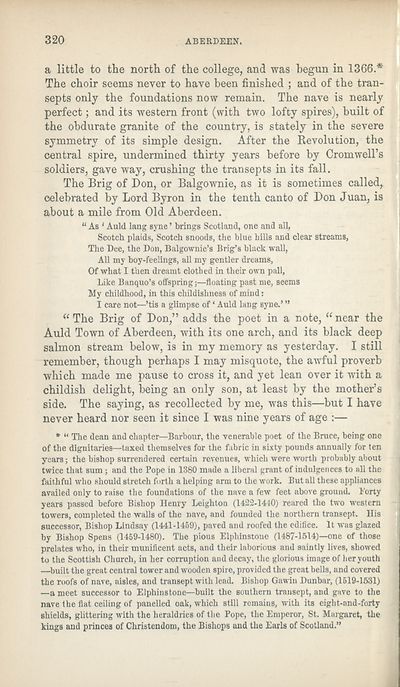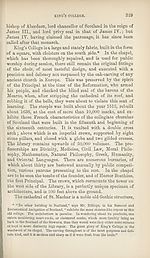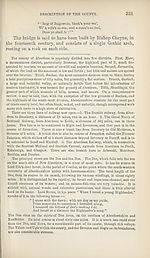Download files
Complete book:
Individual page:
Thumbnail gallery: Grid view | List view

320
ABERDEEN.
a little to the north of the college, and was begun in 1366.*
The choir seems never to have been finished ; and of the tran¬
septs only the foundations now remain. The nave is nearly
perfect; and its western front (with two lofty spires), built of
the obdurate granite of the country, is stately in the severe
symmetry of its simple design. After the Revolution, the
central spire, undermined thirty years before by Cromwell’s
soldiers, gave way, crushing the transepts in its fall.
The Brig of Don, or Balgownie, as it is sometimes called,
celebrated by Lord Byron in the tenth canto of Don Juan, is
about a mile from Old Aberdeen.
“ As ‘ Auld lang syne ’ brings Scotland, one and all,
Scotch plaids, Scotch snoods, the blue bills and clear streams,
The Dee, the Don, Balgownie’s Brig’s black wall,
All my boy-feelings, all my gentler dreams.
Of what I then dreamt clothed in their own pall,
Like Banquo’s offspring;—floating past me, seems
My childhood, in this childishness of mind:
I care not—’tis a glimpse of ‘ Auld lang syne.’ ”
“ The Brig of Don,” adds the poet in a note, “ near the
Auld Town of Aberdeen, with its one arch, and its black deep
salmon stream below, is in my memory as yesterday. I still
remember, though perhaps I may misquote, the awful proverb
which made me pause to cross it, and yet lean over it with a
childish delight, being an only son, at least by the mother’s
side. The saying, as recollected by me, was this—but I have
never heard nor seen it since I was nine years of age :—
* “ The dean and chapter—Barbour, the venerable poet of the Bruce, being one
of the dignitaries—taxed themselves for the fabric in sixty pounds annually for ten
years; the bishop surrendered certain revenues, which were worth probably about
twice that sum; and the Pope in 1380 made a liberal grant of indulgences to all the
faithful who should stretch forth a helping arm to the work. But all these appliances
availed only to raise the foundations of the nave a few feet above ground. Forty
years passed before Bishop Henry Leighton (1422-1440) reared the two western
towers, completed the walls of the nave, and founded the northern transept. His
successor, Bishop Lindsay (1441-1469), paved and roofed the edifice. It was glazed
by Bishop Spens (1459-1480). The pious Elphinstoue (1487-1514)—one of those
prelates who, in their munificent acts, and their laborious and saintly lives, showed
to the Scottish Church, in her corruption and decay, the glorious image of her youth
—built the great central tower and wooden spire, provided the great bells, and covered
the roofs of nave, aisles, and transept with lead. Bishop Gawin Dunbar, (1519-1531)
—a meet successor to Elphinstone—built the southern transept, and gave to the
nave the flat ceiling of panelled oak, which still remains, with its eight-and-forty
shields, glittering with the heraldries of the Pope, the Emperor, St. Margaret, the
kings and princes of Christendom, the Bishops and the Earls of Scotland.”
ABERDEEN.
a little to the north of the college, and was begun in 1366.*
The choir seems never to have been finished ; and of the tran¬
septs only the foundations now remain. The nave is nearly
perfect; and its western front (with two lofty spires), built of
the obdurate granite of the country, is stately in the severe
symmetry of its simple design. After the Revolution, the
central spire, undermined thirty years before by Cromwell’s
soldiers, gave way, crushing the transepts in its fall.
The Brig of Don, or Balgownie, as it is sometimes called,
celebrated by Lord Byron in the tenth canto of Don Juan, is
about a mile from Old Aberdeen.
“ As ‘ Auld lang syne ’ brings Scotland, one and all,
Scotch plaids, Scotch snoods, the blue bills and clear streams,
The Dee, the Don, Balgownie’s Brig’s black wall,
All my boy-feelings, all my gentler dreams.
Of what I then dreamt clothed in their own pall,
Like Banquo’s offspring;—floating past me, seems
My childhood, in this childishness of mind:
I care not—’tis a glimpse of ‘ Auld lang syne.’ ”
“ The Brig of Don,” adds the poet in a note, “ near the
Auld Town of Aberdeen, with its one arch, and its black deep
salmon stream below, is in my memory as yesterday. I still
remember, though perhaps I may misquote, the awful proverb
which made me pause to cross it, and yet lean over it with a
childish delight, being an only son, at least by the mother’s
side. The saying, as recollected by me, was this—but I have
never heard nor seen it since I was nine years of age :—
* “ The dean and chapter—Barbour, the venerable poet of the Bruce, being one
of the dignitaries—taxed themselves for the fabric in sixty pounds annually for ten
years; the bishop surrendered certain revenues, which were worth probably about
twice that sum; and the Pope in 1380 made a liberal grant of indulgences to all the
faithful who should stretch forth a helping arm to the work. But all these appliances
availed only to raise the foundations of the nave a few feet above ground. Forty
years passed before Bishop Henry Leighton (1422-1440) reared the two western
towers, completed the walls of the nave, and founded the northern transept. His
successor, Bishop Lindsay (1441-1469), paved and roofed the edifice. It was glazed
by Bishop Spens (1459-1480). The pious Elphinstoue (1487-1514)—one of those
prelates who, in their munificent acts, and their laborious and saintly lives, showed
to the Scottish Church, in her corruption and decay, the glorious image of her youth
—built the great central tower and wooden spire, provided the great bells, and covered
the roofs of nave, aisles, and transept with lead. Bishop Gawin Dunbar, (1519-1531)
—a meet successor to Elphinstone—built the southern transept, and gave to the
nave the flat ceiling of panelled oak, which still remains, with its eight-and-forty
shields, glittering with the heraldries of the Pope, the Emperor, St. Margaret, the
kings and princes of Christendom, the Bishops and the Earls of Scotland.”
Set display mode to:
![]() Universal Viewer |
Universal Viewer | ![]() Mirador |
Large image | Transcription
Mirador |
Large image | Transcription
| Antiquarian books of Scotland > Scotland/Scots > Black's picturesque tourist of Scotland > (414) |
|---|
| Permanent URL | https://digital.nls.uk/130033158 |
|---|
| Description | Thousands of printed books from the Antiquarian Books of Scotland collection which dates from 1641 to the 1980s. The collection consists of 14,800 books which were published in Scotland or have a Scottish connection, e.g. through the author, printer or owner. Subjects covered include sport, education, diseases, adventure, occupations, Jacobites, politics and religion. Among the 29 languages represented are English, Gaelic, Italian, French, Russian and Swedish. |
|---|

